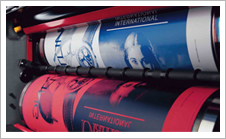2013
 If you’ve ever dabbled into the world of package design, the odds are that you’ve heard the words “offset lithography” thrown around once or twice but you might not be clear on exactly what it is.
If you’ve ever dabbled into the world of package design, the odds are that you’ve heard the words “offset lithography” thrown around once or twice but you might not be clear on exactly what it is.
First things first, offset lithography is the most frequently used printing process in the design, and it’s been around for a long time. Robert Barclay patented the first offset lithographic printing press way back in 1875. The technique involved a traditional offset cylinder covered with specially treated cardboard. The cylinder transferred the printed image to the surface of menu. Shortly after, the offset cylinder was changed to rubber, which is the most commonly used material to this day.
Today’s offset lithography process is extremely similar. The bare bones of the technique are as follows: an inked image is transferred (offset) from a metal plate, to a rubber blanket, and then finally, to the printing process. This tactic is combined with the lithographic process, which is essentially based on the well-known fact that water and oil don’t mix.
To put it into simpler terms, the image carrier obtains ink from ink rollers, and the non-printing area attracts a “fountain solution” (a water-based film), which keeps the non-printing areas clean and ink-free.
It might sound complicated if this is the first time you’re reading about it, but in reality, offset printing is the easiest ways to produce huge volumes of quality prints in a relatively short amount of time. This makes it ideal for use in the packing industry, where large quantities of packages must be produced on a mass scale. It also offers the following perks:
- Consistently good image quality. The rubber blanket used in offset printing conforms to the texture of any printing surface, which is ideal for the packing industry which is always changing.
- Quick and easy production of different printing plates.
- Longer printing plate life than other presses since there is no direct contact between the plate and the printing surfaces. A well-built plate used with quality inks and fountain solution can run millions of impressions.
- Environmentally sensitive, if some of the more modern “direct-to-plate” processes are used
It’s hard to believe that something that’s been around for close to 150 years is still such a useful tool in the industrial world to this day. But, as the old saying goes: “if it ain’t broke, why fix it?” Offset lithography has more-than-earned its name in the packaging industry, and the world of printing in general, and we won’t be surprised if it sticks around for another 150 years and onward!
 Recent Posts
Recent Posts
- 5 Things to Consider When Packaging Food
- How Does Hot Foil Stamping Work?
- 5 Tips for Monochrome Packing
- How To Choose The Right Boxes For Your Business
- What Type of Information Is Legally Required for Package Design?
 Categories
Categories
- Announcements
- Company Information
- Frequently Asked Questions
- General Category
- Goldrich
- Newsletter Articles
- Product News
- Testimonials
Deprecated: Function wp_list_cats is deprecated since version 2.1.0! Use wp_list_categories() instead. in /home/goldpakcom/public_html/wp-includes/functions.php on line 6121
 Archives
Archives
- March 2015
- February 2015
- January 2015
- December 2014
- November 2014
- October 2014
- September 2014
- August 2014
- July 2014
- June 2014
- May 2014
- April 2014
- February 2014
- January 2014
- November 2013
- October 2013
- September 2013
- July 2013
- June 2013
- May 2013
- April 2013
- March 2013

 Proudly Canadian Since 1953
Proudly Canadian Since 1953